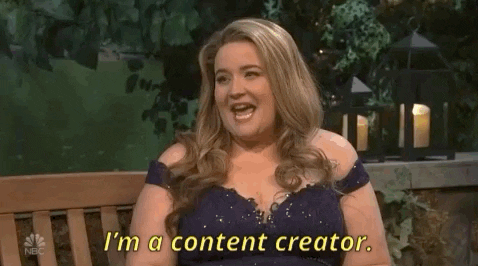Before I spent all of my free time listening to podcasts I watched a ton of Reality TV. I’m talking every single episode of every single season of every single Real Housewives franchise plus the RHWBH spin-off Vanderpump Rules. I’m talking The Bachelor, The Bachelorette and their subsequent spin-offs. And don’t even get me started on Love Island (US and UK). The big takeaway in all of my guilty pleasure binge watching is that it’s nearly impossible to identify one Bachelor contestant from another, one Housewife from the next, and one tan, muscley Love Islander from Wales from one tan, muscley Love Islander from Leeds. And, clearly, reality TV producers are aware of the blurred lines between characters and problem-solved this evergreen issue with title cards to introduce people as they enter each scene. With most reality TV shows, the audience is reminded of who each contestant/character is by a title card displaying their name across the screen at periodically throughout an episode. Sometimes there is a clarifying statement like the person's occupation or relationship to another person on the show.
With reality tv programming this type of title card is the only way to keep track of each person as an idividual — even if you stick with a show for an entire season. The character title card has become the standard to the point that it’s parodied on Saturday Night Live.
Although I’ve found a better use of my time and now choose listening to podcasts over watching my guilty pleasure TV programs, I've noticed that it can be hard to identify who is talking when. This is especially evident in interview style shows hosted by more than one person. Between co-hosts, sidekicks, and a roster of guests, it can be difficult to figure out who’s who. And the level of confusion increases when each person featured on a show doesn’t have an effective way of standing out from the crowd. If the two hosts have voices similar in tone, with similar patterns of speech, and we do not know enough about them as individuals, it’s harder for a listener to stay tuned in to an episode. Ultimately this might force them to switch over to another show in their queue.
The good news: it is possible to build rapport with your co-host, deepen your connection with the listeners, and maintain your unique narrative voice. Here are a three tips on distinguishing yourself as a co-host and three examples from co-hosted shows that really stand out from the crowd.
Think of your co-host persona as a character
Help build the world of your podcast for your listener by identifying your individual story as a podcast host. What do you want the audience to know about you from the beginning? How much backstory is needed for the person listening to understand who you are and where you're coming from? What are the interests, hobbies, fears, strengths, and weaknesses that set you apart from your co-host? What makes you laugh? What do you feel most compelled to share about yourself? What feels vulnerable yet necessary for your listener to hear?
Call Your Girlfriend is a podcast that has been around since 2014. And because it is a long-running show that produces episodes weekly, the co-hosts have had plenty of time to establish themselves as individuals. Whether you tune in for every episode, or jump back in from time to time, you always know who is speaking when and what perspective each is bringing to the table. Both Aminatou Sow and Anne Friedman have strong personal brands outside of the podcast, allowing the listener to stay connected to them as individuals and giving them the opportunity to learn more about each of them.
Call Your Girlfriend Episode 218: Death Becomes Her has a great opening segment where Aminatou plays with the audience and her co-host by changing up their standard podcast intro. This playful joke at the top of the episode moves into back-and-forth banter about films, the generational difference between an elder millennial and a millennial, building upon the strong (and genuine) personas that have built as individuals podcast “characters”. Another way that Anne and Aminatou establish their unique hosting style is by taking turns when leading interviews. They do not always interview their guests together, allowing the listener to stick with one host for longer. In Episode 218, Anne takes the lead interviewing Caitlin Doughty.
Tell stories to each other (and together)
When co-hosting a podcast, it's important to infuse personal narrative from each host into every. single. episode. This can be a stand alone story that fits the theme of your episode, or a story that builds chapter by chapter throughout your show’s season. Allowing for time in your episode for a story from each co-host will ground the listener in your individual experiences.
You can also tell a story collectively! A beautiful example of a podcast where each show shares in the story telling duties is Strong Feelings Episode 78: Women in Beer. Co-hosts Sara Wachter-Boettcher and Katel LeDû share an eye-opening experience that they had in a coaching training program in NYC. They each give their perspective on what the experience is like and take turns bringing the listeners into the scenes of the story.
To make space for story sharing, build out a segment in each episode for you and your co-host to swap anecdotes and support each other as humans beyond your role as podcast host. At the end of each Strong Feelings episode, Sara and Katel celebrate their individual wins of the week with a segment called “Fuck Yeah”. They’ve even carried this segment into their in-person community events, closing out each of their monthly Collective Strength gatherings with group “Fuck Yeah” sharing.
Give your co-host space to talk and listen
Co-hosting can be tricky in that the level of excitement is twice as much and this can lead to interrupting your co-host even if not the intention. Excitement builds to interruption and interruption builds to talking over each other. Make sure that in prepping for the show, you and your co-host have an outline and notate of who is speaking when. Of course this can change in the moment, but giving yourself a framework of talking points is a great way to avoid clipping the end of each other’s sentences. Your show’s audience should feel you listening to each other. Create space for your listeners to connect with each of you as individuals. Give your co-host space to talk and then listening deeply to what they have to say. This will enable you to respond to each other in a more impactful way.
ZigZag is a podcast that is primarily hosted by Manoush Zomorodi. Manoush is already a recognizable podcast host with her gigs hosting Notes to Self and now the TED Radio Hour. But producer (and business partner) Jen Poyant is pictured with Manoush on the podcast’s album art and has taken on a larger co-hosting role as the show has settled into its narrative voice. ZigZag just wrapped up Season 4 and got into the rhythm of ending each show with a rumination of what they got out of that guest's interview and how it relates to their work together building out a new media company. ZigZag Season 4, Episode 4: When your Gut Tells You It's Time to Quit Your Company is a great example of giving space to your co-host and digging deeper into the conversation through active listening.
To get a sense of a variety of co-hosting styles listen to the episodes mentioned above. Looking for more examples of co-hosted shows? Check out The Opt-in, Still Processing, and By the Book.
Want to read more posts from Tell Me A Story related to podcasting? Check out How to Conduct Podcast Interviews That Showcase Your Guests' Brilliance .




